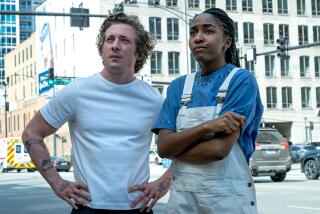Arab Caricatures Deface Disney’s ‘Aladdin’
- Share via
Walt Disney’s “Aladdin” is not an entertaining Arabian Nights fantasy as film critics would have us believe (“The 1,001 Delights of ‘Aladdin,’ ” Calendar, Nov. 11) but rather a painful reminder to 3 million Americans of Arab heritage, as well as 300 million Arabs and others, that the abhorrent Arab stereotype is as ubiquitous as Aladdin’s lamp.
The problems begin with the film’s defamatory opening number, belted out by a shady-looking storyteller sitting atop a camel, crossing the desert. The song goes like this.
Oh I come from a land
From a faraway place
Where the caravan camels roam.
Where they cut off your ear
If they don’t like your face.
It’s barbaric, but hey, it’s home.
To say a distinct culture is “barbaric” is to show prejudice and accept stereotypes. The song slanders an entire people, setting the tone of the movie. The lyrics and successive scenes inform viewers that Arabs are not like us: They are uncouth.
It’s acceptable for a songwriter to single out a villain, but the moral obligation is to represent an individual, not his race. Such is not the case with “Aladdin,” which, like hundreds of Hollywood features, bombards audiences with repulsive depictions. Ever since cameras started cranking, Arabs have been classic victims of screen stereotypes. The pervasiveness makes it arduous for viewers to separate fact from fiction.
Beginning with “Aladdin’s Lamp” (1907), movie makers have gone on to present more than a dozen Aladdin/lamp fantasies featuring genies ranging from a nearly naked female to an animated jolly green giant.
Disney’s reproduction of Aladdin’s adventures takes place in the mythical desert kingdom of Agrabah, which is not a center for Arab culture or civilization; nor is it an extension of amusement parks such as Disneyland or Disney World.
Instead, Agrabah is a wing of Hollywood’s fabricated Ayrabland, complete with a foreboding desert castle featuring Arabesque cupolas. Surrounded by poverty and intrigue, “Aladdin’s” mythical Ay-rabland depicts thieves and unscrupulous vendors. No merchants appear as charitable types; their appearance and behavior are modeled after the Sultan’s cruel, dim-witted sentinels.
While watching the movie, I mused: What effect will “Aladdin’s” characterized Arabs, who appear as dastardly villains and harem maidens, have on youngsters? What impressions of Arabia will small children have when hearing “Arabian Nights,” a song whose main enticement is uncivilized folk advocating ear-chopping? What will kids make of hideous Arabian guards chasing Aladdin throughout the film, scabbards flying, just because the famished youth stole a loaf of bread?
What will youngsters think of dialogue enhancing the abhorrence of the Arab theme? For example, a brutal guard screams at Aladdin, “I’ll have your head for a trophy, you street rat.” What will children reason about Islam, a religion embraced by more than 1 billion people, on hearing a street vendor insist that the standard penalty for stealing is chopping off one’s hand? One telling scene shows a grotesque Arab, scabbard poised, about to remove Princess Jasmine’s hand, simply because she took an apple to feed a starving child.
Finally, what will children think of Jafar, a hissably vain vizier, determined to “slice a few throats”?
Given the harmful effect predominant antagonists such as Jafar and others may have on children, how can noted critics champion “Aladdin” for anyone, 5-year-olds or grown-ups? “Aladdin” should have been a vehicle to shatter caricatures. Instead, the film narrows our vision and blurs reality.
If, like Aladdin, I came across the enchanted lamp with a genie granting me three wishes, what would I ask for?
One, I’d wish for Disney Studios to alter or delete the opening “Arabian Nights” ditty before releasing “Aladdin” on videocassette.
Two, I’d ask the animators to add benevolent market-vendors and heroic guards who befriend Aladdin. At least three previous films--”Aladdin’s Lamp” (1907), “Aladdin and His Wonderful Lamp” (1917) and “The Wonders of Aladdin” (1961)--highlight the Sultan’s bold and brave horsemen.
For my third wish, I’d ask “Aladdin’s” producers to respect Islam and to add a humane character, Aladdin’s lovable mother, an Arab woman willing to sacrifice everything for her son’s happiness. As for Islam, producers could emulate the dialogue from “Aladdin and His Magic Lamp,” where the characters say: “Allah gives us the morning” and “Allah gives us the lovely day.”
There’s a profound lesson to be learned from watching “Aladdin” films, especially if one compares the potpourri of genies popping out of lamps and bottles with Hollywood’s myth makers. Just as Aladdin’s genies traditionally serve as serfs to the lamp, filmmakers typically function as slaves to the stereotype.
Sadly, repetitious and negative Arab images literally sustain adverse portraits across generations. There is a commanding link between make-believe aberrations and the real world. It has been said that “stereotypes have the longest half-life in the history of the globe. They will not go away.”
Cable television and videocassettes eventually make it feasible for viewers to see “Aladdin” and other motion pictures demonizing Arabs as often as they like. Like books, films last forever.
More to Read
Only good movies
Get the Indie Focus newsletter, Mark Olsen's weekly guide to the world of cinema.
You may occasionally receive promotional content from the Los Angeles Times.










